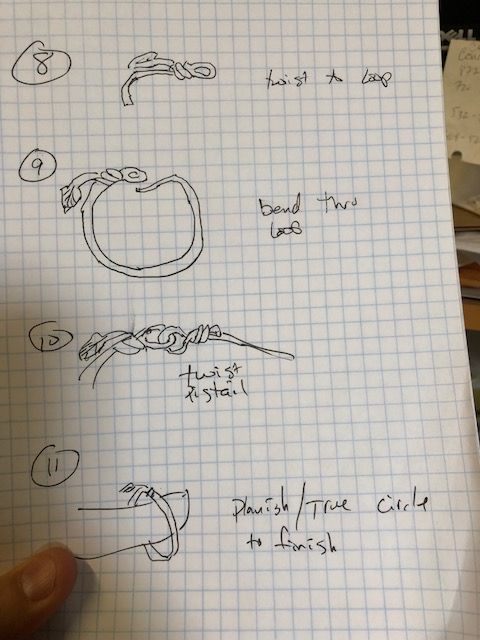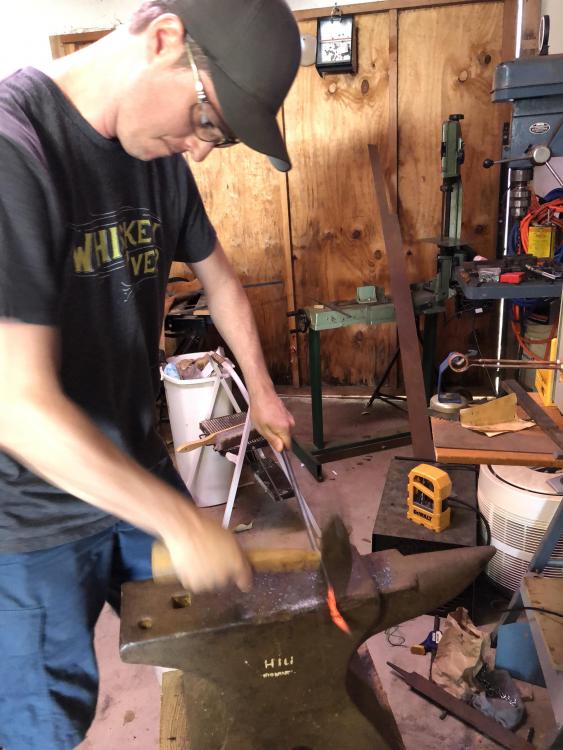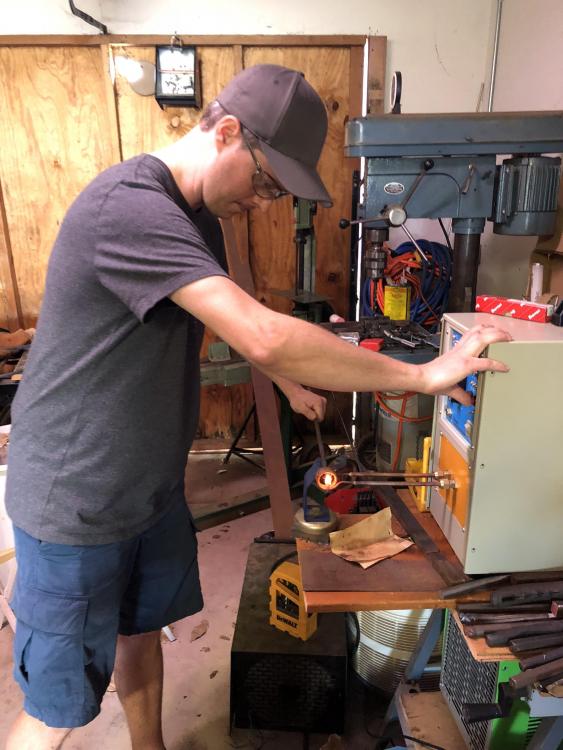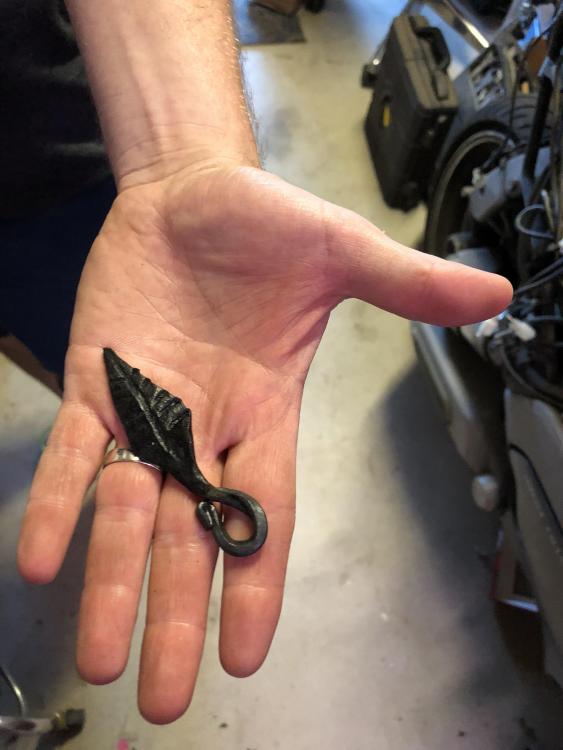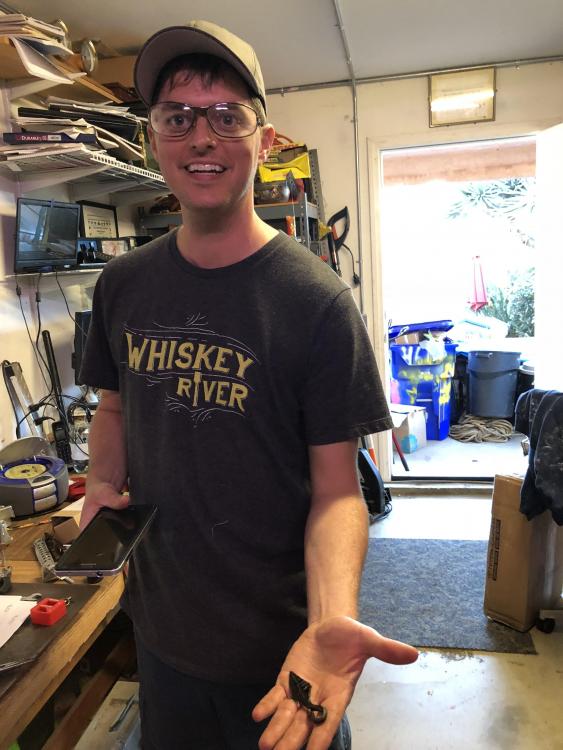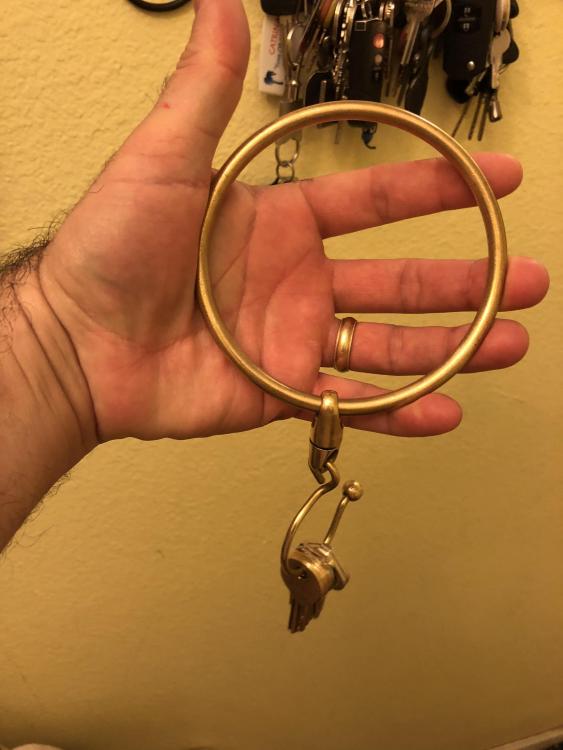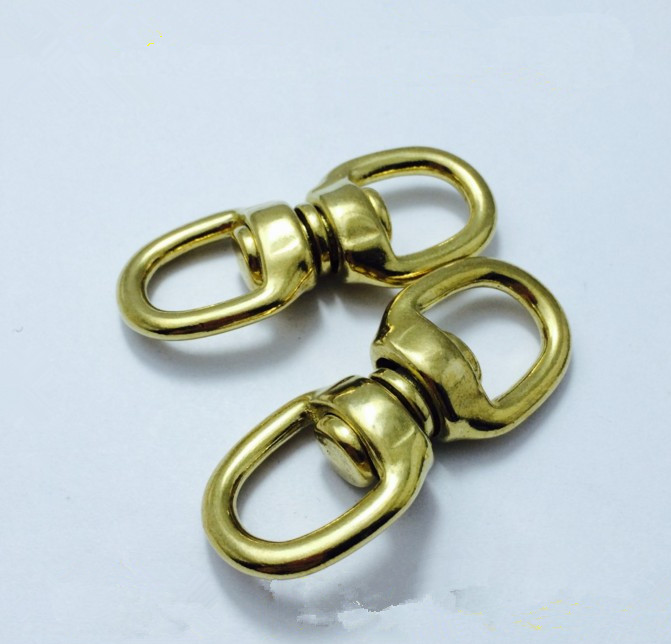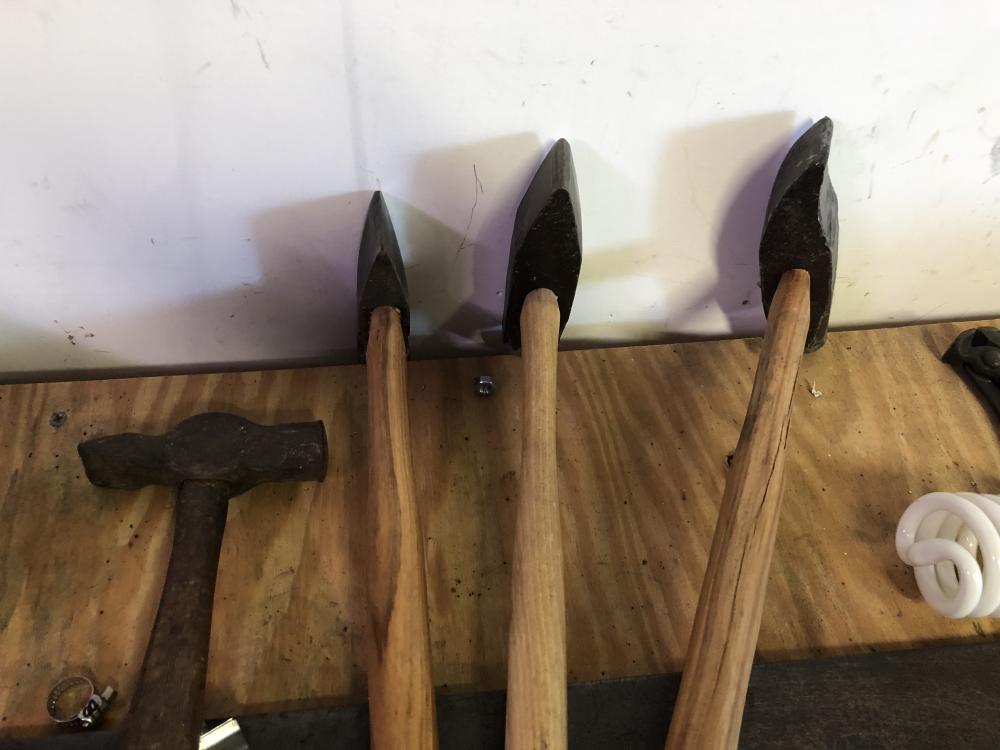
bajajoaquin
Members-
Posts
495 -
Joined
-
Last visited
Content Type
Profiles
Forums
Articles
Gallery
Downloads
Events
Everything posted by bajajoaquin
-
I’ve noticed that the Klein Lineman’s hammer looks an awful lot like a rounding hammer. Any reason it isn’t basically interchangeable with one?
-
It’s a ground for a portable generator. You drive the stake into the ground then hook up the genset.
-
Forging a Teacher's Key Ring
bajajoaquin replied to bajajoaquin's topic in Blacksmithing, General Discussion
Is there a simple thumbs up emoticon? Thank you! -
There, I fixed it for you
-
I mentioned in another post on how to make a swivel that I want to make a big ring for holding teacher's keys as a present for my sister-in-law when she finishes her teaching credential. I am broadly modeling it on my wife's brass ring that her grandmother used when she was a teacher. Rather than have a seamless brass ring, I'm intending to forge square bar to round, add a leaf and then make the ring by twisting the loops together. I'm fairly limited as a blacksmith, having only dabbled over the years and mostly made things from other peoples' examples. As a result, I'm not sure the best sequence of forging operations to use. I've drawn out my plan, and I'd appreciate comments. I'm looking at the ring now, and will probably add in questions for the hook and the swivel, when those come. Some notes: ring will be about 5" in diameter, which comes to about 17.25" in circumference. adding in material for the leaf, stem, taper, loops and wraps, my finished length should be about 22-23". Stock will be 3/8" bar ultimately forged to 3/8" round (except for the leaf, stem, and taper). Pictures attached for reference. You might note that my forging ability is rivaled by my sketching ability! 1. Forge steep taper for leaf shape. 2. Isolate taper for body of leaf 3. Draw out stem of leaf to 1/8" or so for about 3" 4. Forge 3/8" square to 3/8" round for the length of 17.25" from end of leaf stem. Mark with center punch at that point 5. Taper to point 3.5" long, cut off remaining 6. Flatten and vein leaf 7. Forge mostly round 8. Bend leaf back and twist to loop 9. Bend opposite side taper to fit through loop 10. Twist taper around ring to secure 11. Planish/true ring on horn What are your thoughts on this? Changes? Additional Detail?
-
He’s my coworker and lives in Louisville. I’m in San Diego. We had a work meeting here and when he left home they were looking at 10” if snow. It’s been in the 70s and sunny every day here. After the meeting, he had his family fly out for vacation. So rather than shoveling snow, he’s been going to the beach, riding my tandem bicycle (with mid seat), and now learning to blacksmith. So that’s the look of a guy in the middle of a good vacation! With regards to forging with both hands, I heard it said once that one of the two most important skills to be a good surgeon was being completely ambidextrous (the other was being able to visualize in three dimensions). Never thought of it before, but that would be awfully handy (heh heh) in blacksmithing, too.
-
Thanks. I really like it. There are real limitations in size and shape I can forge as well as when I need a long even heat. The trade off is that I turn it on and 30 seconds later, my stock is at a forging heat. I have very little time these days to forge and anything I get is due to the time saved with the induction forge.
-
He’s having problems with the his neck which manifested in reducing his grip in his left hand. He was unable to hold a hammer to swing it.
-
Not my leaf, but I had a friend over who tried his hand at forging today. Not bad for a lefty forging with his right hand.
-
Why blacksmithing? initial pull
bajajoaquin replied to Tock's topic in Blacksmithing, General Discussion
This is exactly why I love blacksmithing, surfing, motorcycle riding and everything else I do for relaxation. I need something that demands my whole attention to quiet my mind. It might sound crazy but I really need the things that keep me on a single thing. While that’s why I love to smith far out of proportion to my ability, it doesn’t answer the question. I started because my dad and especially my grandfather made stuff, mostly from wood. When my grandfather died, he gave me his last piece, a cherry rocker he’d built in the Sam Maloof style. Unfortunately, I never got anything done. It wasnt until i thought about making things from metal that I realized the medium mattered. Once I thought about metal, I soon bought a welder, cutting and fitting tools. While looking for information about how to weld, I came across forge welding and blacksmithing. I found out that the there was a great program through the CBA at the Vista Forge and started in 200......6? I’ll have to check my badge. More than a decade later, I still suck. Really bad. And it’s not false modesty. But I still really love and crave the peace it gives me. -
There seems to be a lot of enthusiasm for that band saw. What’s the functional difference between that and a 4x6 saw other than portability? What’s the difference in price?
-
Thought you all might appreciate this...
bajajoaquin replied to KILLERkroopa's topic in Blacksmithing, General Discussion
Very cool -
Working in an Indian smithy
bajajoaquin replied to Ali Ahmed Khan's topic in Blacksmithing, General Discussion
Any time you’re in India and you tell someone you’re going to Kerala, their eyes open a bit and say “Kerala is a beautiful place.” And it’s true. Also the only state in India where you can legally have an elephant as a pet. That pic of he smithy was good, thanks. You can see the blower behind the swage-block pyramid thingie and I’m guessing it has an air tube under it to a fire “pot” in the dirt on the near side (in the photo)? That’s a step above the one I went to, but otherwise pretty close in overall feel. -
Working in an Indian smithy
bajajoaquin replied to Ali Ahmed Khan's topic in Blacksmithing, General Discussion
+ 1 on this. I'd be curious to see the pics of the stuff you brought back.I am really curious to know what can be bought for $20 in India, as I go once a year for work. Also to know where you went. India is a strangely big place. Big in the sense that there's a lot of people and varied geography, but weird in the sense that it's still about a third the size of the US. Is there a member from Kerala, or are you remembering my visit to Kerala a while back? As was mentioned, the main thing that the smith I visited forged was utilitarian: rubber taps. He showed me one and tried to teach me to make one. His anvil was a block of mild steel about 9" on a side set loosely on the ground. Forge was a blower that had a metal tube blowing into a hollow in the dirt. Fuel was wood that reduced to charcoal as he worked. He forged sitting cross-legged with the anvil bouncing around in the heat and humidity and the fire singeing the hair on his leg (or mine, at least, when I tried to sit where he did). I found it so awkward and uncomfortable that I could do almost nothing. He, however, forged effortlessly and with great skill. I still have the knife he made me from a leaf spring. Still makes me smile every time I use it. To Sunil, that's part of your answer. Don't get hung up on some pre-conceived notion of what anvils or tongs or forges should look like. According to The Complete Modern Blacksmith, a forge can be as simple as a metal can with a really tall chimney and using charcoal for fuel. The draft was enough to get metal to forging temperature. There are lots of forges here that are made from brake drums, mud, old BBQs, and hair dryers or simple bellows. UAE has tons of construction. Where there's construction, there are scrap yards. A big snapped truck axle piece would make a serviceable anvil. Any hammer without a textured face (like for driving nails) will work. -
Forging a Double Swivel
bajajoaquin replied to bajajoaquin's topic in Blacksmithing, General Discussion
Two great responses! I have a copy of practical blacksmithing but I won’t tell Thomas. That way, if I am in his neighborhood I can take him up on his offer . and that video is great. I came up with some drawings and ideas last night too. I looked less at trying to duplicate the item and more at achieving the function. -
I’m looking to make a teacher’s key ring for my sister in law for when she gets her teaching credential. I’m prepared to buy a double eye swivel if I need to, but I thought I’d ask here to see if anyone has any tips for forging it. I’ve included a pic as well as the one my wife has (it was her grandmother’s so I’m not going to try to compete with that sentimental attachment)
-
So.... how about some details on those hoof picks/bottle openers?
-
New Induction Forge
bajajoaquin replied to bajajoaquin's topic in Induction Heating, Oil forges, etc
A long time in replying, but yes, that’s what I intend to do. One of the things I’ve seen is that these use a metric tube size that’s hard to find here. One of the things I bought from Mettle Works was replacement flare nuts that mate the metric threads on the machine to standard tube diameters. Was it necessary? Maybe not but it’s faster for me to do that than waste time dithering and also they were so helpfu even though I didn’t buy my forge from them. I don’t buy much blacksmithing stuff new but when I do, they’ll be first on my shopping list. I don’t get much time to forge, but when I do, the forge is exactly what I hoped it would be. I can turn it on, take 20-30 minutes to forge a new gate hasp and turn it off. If someone comes over who says “I’d love to try blacksmithing,” we can have an impromptu leaf key fob lesson after dinner. Boring hour long conference call where my speaking role is done in the first ten minutes? Get some work done on the candle snuffer with a basket twist for my wife’s Xmas present! Its not much, but it’s more than I’d forged in the previous three years or so, so I’m pretty pleased. -
I sold my Atlas mill recently and the guy brought some “hammers” he had. They look more like struck tools to me. Any opinions? In particular, what is that curved tool for?
-
Home build induction heater
bajajoaquin replied to Daniel.85's topic in Induction Heating, Oil forges, etc
I’ve been away but came back looking for this thread. So happy it’s coming out well. I have gotten my induction forge back up and going and have been really enjoying it. Super cool that you’ve been successful. -
Oh, that’s not how I read it at all. It’s just a notice that they checked your bag, not a note telling you it was inappropriate. I’ve checked 20lb of frozen bacon with dry ice (technically prohibited in the quantity I had) and there was a note in there. Have seen it when there’s just clothes. Of all the lame things associated with TSA, that’s not really one of them.
-
Any updates?
- 48 replies
-
- cotrol power
- 2kw power
-
(and 3 more)
Tagged with:
-
I really wish I had the electronics skills to attempt this. I think it might be kind of like how hot rodders really feared fuel injection when it came onto the scene. Induction heating isn't new technology, and the things to make it happen are available in the marketplace. There's no reason other than experience and technical skill that more people shouldn't be making induction heaters. Both of those are reasonable to acquire for normal people. Keep us posted!
- 48 replies
-
- cotrol power
- 2kw power
-
(and 3 more)
Tagged with:
-
New Induction Forge
bajajoaquin replied to bajajoaquin's topic in Induction Heating, Oil forges, etc
One of the things that is an additional expense on these forges is the cooling setup. You buy the forge, then you need to cool it. As I mentioned above, I bought a used Miller TIG torch for mine. Today, I discovered that it leaks. A new pump is $200, a rebuild kit is $100, but a seal is $17. The gentleman at Depco Pump recommended that I buy a seal for it, and replace it as necessary until the pump fails. Done. I've used it a little bit more, and I've gotta say it's pretty amazing. You go from cold to a forging heat in seconds. Welding heats take longer, but only like 30 seconds. To be able to go from nothing to forging in less time than it takes to turn on all the machines is pretty unbelievable. The down side is that the coil really restricts the shapes and sizes you can work with. As I get more into this, I'll be making some additional coils. I've seen a double (with two different diameters), but I'm wondering if I can make a triple coil. If you could have something like a 1.5" or 2" for fitting flattened leaves, basket twists, etc., a 1.25" coil for a lot of general work, and then a .75" coil for the thin tapers, I think you'd have a really effective set-up. -
New Induction Forge
bajajoaquin replied to bajajoaquin's topic in Induction Heating, Oil forges, etc
I was going to put up some pics, but I see that I didn't take many, and the ones I did look like spaghetti. I'll try to take some clear ones now that I have initial setup complete. As I said above, I wouldn't have done this if Eric Jergensen hadn't written that article about his setup. I just didn't have the money to buy one from Mettle Works, and I wouldn't have been confident enough to navigate he various vendors myself. I don't know anything about electronics and electricity scares me. To make a long story short, I contacted him, he shared the name of the vendor and I ordered one. It shows up in a cardboard sleeve, with the crate apparently having broken down around it. I hired an electrician to put in a new 40 amp breaker and outlet, wore the pigtail, and it still worked. While I was doing that, I was figuring out my cooling setup. Eventually I pieced together enough info to figure out how to put together a cooler from second hand materials, but an old Miller Radiator 1 came for sale in my area. I bought it. When it came time to hook it up, I noticed that there were two inlets and three outlets on the forge for coolant. When I asked the vendor about it they said "yes. Hook up three outlets and two inlets." Not super helpful. Again, with the help of Eric, I figured out my routing. The induction coil that comes with the forge oriented vertically. Not knowing how to make one yet, I contacted Mettle Works and ordered a couple. I also told him that I'd boughtdorect and that any insight he could give me would be appreciated but totally above and beyond. He was, of course very gracious and helpful. I tested it out last couple of days and forged my first item on it today. It was a simple leaf key fob from Dave Vogel's CBA. cirriculum. For my first forged product in about four years, I think it came out well. I love the forge. I was able to go to my forge,turn it in, and forge a small item in less time than it would have taken to light my coal forge. In fact, I did it while on a conference call (on mute of course). Would I recommend this path to someone else? Depends. If you have the money spend it to go with a US supplier like Mettle Works. I'm flying without a net and if anything goes wrong I'm out a thousand bucks with no recourse. It was uncomfortable for me to navigate the some of the issues. That would be with the money to have back up. If, however, you just don't have the cash, and you're willing to risk what little you have, it can be done. Its just not the way I would have done it if I'd had another viable option

